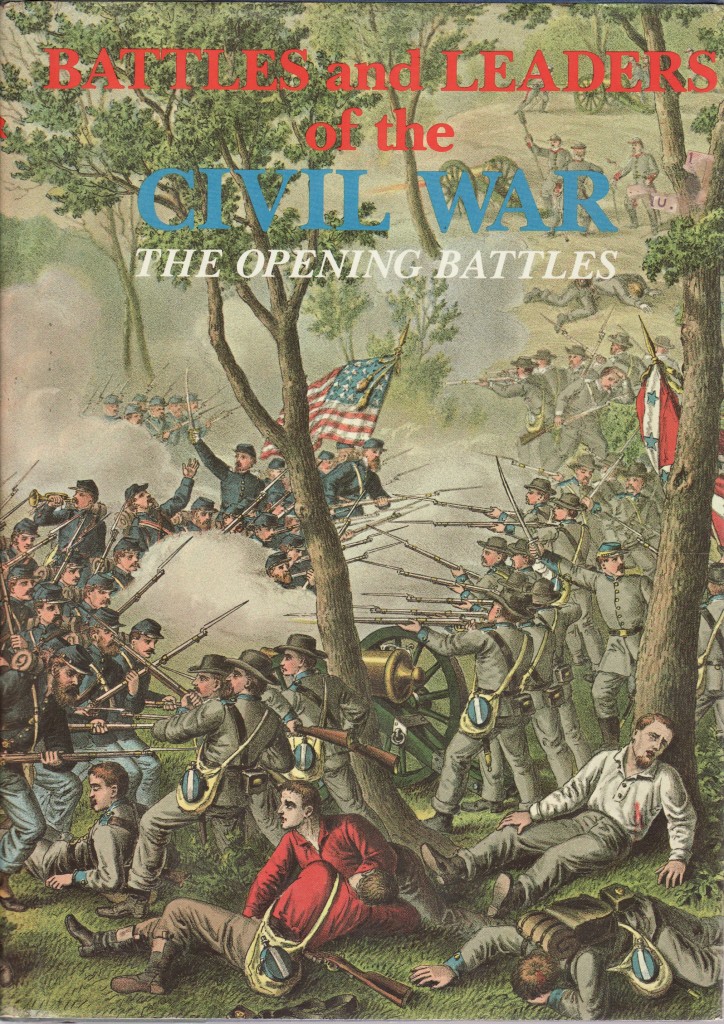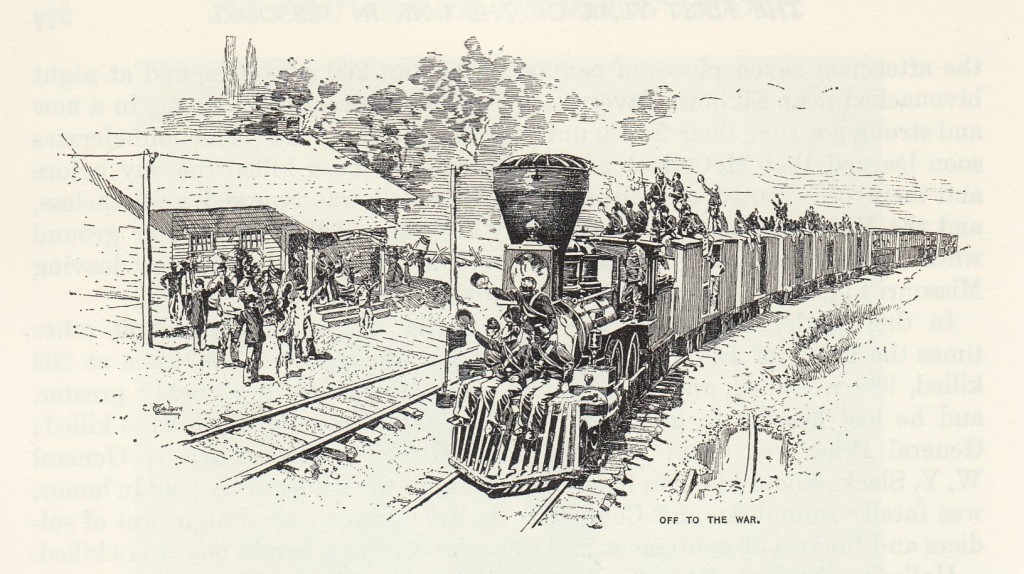Battles and Leaders of the Civil War: The Opening Battles
Posted By Norman Gasbarro on May 22, 2011
(Part 1 of 4). In 1883, Clarence Clough Buel, the Assistant Editor of The Century Magazine, proposed a series of articles which would present differing points of view on the Civil War. Buel’s plan included the eventual publication of the articles in book form. In 1887 and 1888, the four volume work was first published.
From the Preface to the four volume set:
With the main purpose in its origin of interesting veterans in their own memories and of instructing the generation which has grown up since the War for the Union, the “Century War Series,” through peculiar circumstances, has exerted an influence in bringing about a better understanding between the soldiers who were opposed in that conflict…. Many commanders and subordinates have here contributed to the history of the heroic deeds of which they were a part…. For the most part, each side has confined controversy to its own ranks, and both have emphasized the benefit as well as the glory of the issue. Coincident with progress of the series… may be noted a marked increase in the number of fraternal meetings between Union and Confederate veterans, enforcing the conviction that the nation is restored in spirit as in fact, and that each side is contributing its share to the new heritage of manhood and peace.
A re-publication of the four volume work was completed by Castle Books of Secaucus, New Jersey. There is no re-publication date on the Castle Books edition. This re-publication is relatively inexpensive and generally available through book sellers on the web. Some of the volumes are also available in various digital formats, including “pdf” and formats designed for digital book readers.
When the books were originally published they were highly praised because they provided first-hand accounts of the war by men who had actually been present at the events they were describing. Thus they are considered primary source material on the war, even though, for the most part, the articles contained therein were written about twenty years after the war was over. The writers include generals and privates as well as ordinary citizens who took part in the war. These articles have been widely quoted and utilized, including by well-known Civil War historian Bruce Catton, and the four-volume set appears in the bibliography of most scholarly works on the war.
The books contain excellent engravings and maps, the portraits and scenes being engraved from original photographs taken at the time of the Civil War and now in the collection of the Library of Congress. Samples of those drawings and pictures are reproduced in this post as part of the review of each volume.
One major criticism of the series is that there appears to be an attempt on the part of some of the contributors, particularly those on the Southern side, to provide an after-the-fact, re-constructed history of the war – justifying actions on a different basis than decisions were made during war time. Another criticism is that the first three volumes contain no index; a combined index appears in Volume IV. Finally, there are a number of errors and the “errata” pages which appear at the beginning of each volume need to be consulted, making the task of verifying information all that more difficult than had the series been properly edited in the first place. These shortcomings are not enough to take away from the overall effort and achievement of The Century Magazine in conceiving and producing the four volumes. No other work of the late nineteenth century provides such a comprehensive view of the Civil War from as many perspectives as does this series.
Today’s post focuses on Battles and Leaders of the Civil War: The Opening Battles, Volume I, of “The Century War Series” – being for the most part contributions by Union and Confederate officers based upon “The Century War Series,” edited by Robert Underwood Johnson and Clarence Clough Buel, of the editorial staff of The Century Magazine.
This review is divided into four parts. First, an overview of the Table of Contents of this volume will be presented. Included in the Table of Contents overview will be the page number where the organization of the opposing armies appears for the specific battle or campaign described in that section. In previous posts on this blog it was pointed out that knowing which Pennsylvania regiments participated in which battles and in which parts of the army taking part in the battle, was essential to understanding what role the individual soldier played in the battle. These “organization” lists provide not only the names of the regiments, but also the commanding officers – down to the rank of Captain of the individual regiment. Within each section of the table of contents, there could be as many as fifteen articles – too many to describe in this post. Consulting the actual book is a must.
The second section of the review lists the Pennsylvania regimental references from the Index. It has to be noted that these references pertain to the text of the articles and do not note the Pennsylvania regiments that are named in the “organization of the opposing army” articles that are described above. The index also does not cover the many maps that appear throughout the four volumes.
The third section of the review portrays some sample pictures from each volume. An effort has been made to provide a variety of types of pictures – line drawings as well as engravings made from photographs – to show the quality of the material presented.
Finally, some effort is made to tell of the availability of the individual volume.
——————————
CONTENTS OF VOLUME I
FORT SUMTER.
ORGANIZING FOR THE CONFLICT.
FIRST OPERATIONS IN VIRGINIA.
FIRESIDE AND FIELD OF BATTLE.
CAMPAIGN OF THE FIRST BULL RUN: The Opposing Armies at the First Bull Run, p. 194.
WILSON’S CREEK, LEXINGTON, AND PEA RIDGE: The Opposing Forces at Wilson’s Creek, Mo., p. 306; The Opposing Forces at Pea Ridge, p. 337.
BELMONT AND FORT HENRY.
MILL SPRINGS, THE BIG SANDY, AND FORT DONELSON: The Opposing Forces at Fort Donelson, Tenn., p. 429.
THE RIVER GUN-BOATS FROM FORT DONELSON TO NEW MADRID: The Opposing Forces at New Madrid (Island Number Ten), Fort Pillow, and Memphin, p. 463.
SHILOH: The Opposing Forces at Shiloh, p. 537.
NAVAL PREPARATIONS.
COAST OPERATIONS IN THE CAROLINAS: The Opposing Forces at Roanoke Island and New Berne, North Carolina, p. 670; The Opposing Forces at Port Royal, p. 691.
MONITOR AND MERRIMAC.
——————————
PENNSYLVANIA REGIMENTAL REFERENCES IN VOLUME I
27th Pennsylvania Infantry: Mobbed in Baltimore, p. 151.
51st Pennsylvania Infantry: Roanoke Island, p. 643. New Berne, p. 648-9. South Mills, p. 654.
——————————
An example of a picture from Volume I follows:
The picture is a generic example of the type of artwork include in this series. It shows a troop train at an unnamed railroad station as it heads off to the war – a scene undoubtedly repeated at hundreds of local sites throughout the north and south.
Volume I is generally available through new/used book sellers.
In the next three days, one volume per day will be reviewed. Tomorrow: Battles and Leaders of the Civil War: The Struggle Intensifies, Volume II. Tuesday: Battles and Leaders of the Civil War: The Tide Shifts, Volume III. Wednesday: Battles and Leaders of the Civil War: Retreat with Honor, Volume IV.
 ;
;




Comments